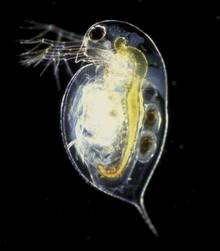Daphnia pulex
| Daphnia pulex | |
|---|---|
 |
|
| Scientific classification | |
| Kingdom: | Animalia |
| Phylum: | Arthropoda |
| Subphylum: | Crustacea |
| Class: | Branchiopoda |
| Order: | Cladocera |
| Family: | Daphniidae |
| Genus: | Daphnia |
| Subgenus: | Daphnia |
| Species: | D. pulex |
| Binomial name | |
|
Daphnia pulex Leydig, 1860 |
|
| External identifiers for Daphnia pulex | |
|---|---|
| Encyclopedia of Life | 338871 |
| ITIS | 83874 |
| NCBI | 6669 |
| WoRMS | 148375 |
| Also found in: ADW | |
Daphnia pulex is the most common species of water flea. It has a cosmopolitan distribution: the species is found throughout the Americas, Europe and Australia. It is a model species, and was the first crustacean to have its genome sequenced.
Daphnia pulex is an arthropod whose body segments are difficult to distinguish. They can only be recognised by the appendages they bear (only ever one pair per segment), and by studying the internal anatomy. The head is distinct and is made up of six segments which are fused together even as an embryo. It bears the mouthparts, and two pairs of antennae, the second of which are enlarged into powerful organs used for swimming. There is no clear division between thorax and abdomen, which collectively bear five pairs of appendages. The shell surrounding the animal extends posteriorly into a long or short spine.
Daphnia pulex occurs in a wide range of aquatic habitats, although it is most closely associated with small, shaded pools. In oligotrophic lakes, D. pulex has little pigmentation, while it may become bright red in hypereutrophic waters, due to the production of haemoglobin.
Daphnia are prey for a variety of both vertebrate and invertebrate predators. The role of predation on D. pulex population ecology extensively studied, and has been shown to be a major axis of variation in shaping population dynamics and landscape-level distribution. In addition to the direct population ecological effects of predation, the process contributes to phenotypic evolution in contrasting ways: larger D. pulex are more visible to vertebrate predators, but invertebrate predators are unable to handle larger D. pulex. As a result, larger D. pulex tend to be found with invertebrate predators while smaller size is associated with vertebrate predators.
...
Wikipedia
